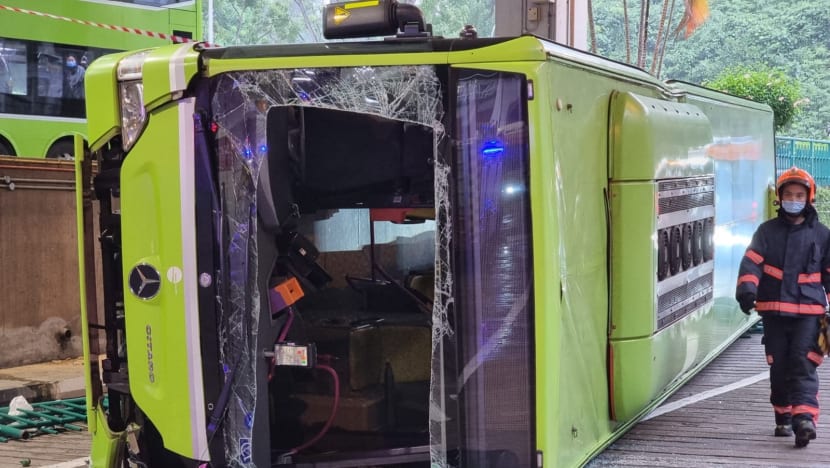Accident rate in Bukit Batok interchange 'not too different' from overall bus accident rate: Chee Hong Tat

The aftermath of a bus collision at Bukit Batok interchange on Jul 11, 2021. (Photo: SCDF)
SINGAPORE: The accident rate at Bukit Batok interchange, where two public buses collided on Jul 11, is similar to the overall bus accident rate, Senior Minister of State for Transport Chee Hong Tat said on Monday (Jul 26).
"The accidents and the near misses data for Bukit Batok interchange is not too different from what is in the general situation that I reported earlier, in terms of the accident rate and also the number of accidents that happen within bus interchanges and also across different settings," he said in Parliament.
Mr Chee was responding to a supplementary question by Member of Parliament (MP) Tan Wu Meng (PAP-Jurong), who had asked if authorities kept track of the number of accidents at Bukit Batok interchange.
READ: 17 injured in bus collision at Bukit Batok interchange, driver suspended
Seventeen people were injured when two service 945 buses collided at the interchange, causing one of the buses to mount a kerb, smash through railings and fall to its side. Only the bus that fell on its side was carrying passengers.
Most of the 15 people who were taken to hospital have since been discharged, Tower Transit said on Jul 12.
Police have also arrested a 65-year-old bus driver for a rash act causing grievous hurt. Tower Transit previously said that the driver of the bus without passengers has been suspended pending investigations.
READ: Bus driver arrested over Bukit Batok interchange collision
Mr Chee said in Parliament on Monday that one of the buses was making a turn within the interchange when it hit another bus that had just entered the interchange.
While he refrained from commenting further on the specific incident, citing ongoing investigations, he said the number of accidents involving public buses in interchanges and elsewhere has been "falling steadily".
There were 148 such accidents between January and May this year, down from 270 in the same period in 2017, he said.
The average yearly accident rate for public buses has also decreased from about 0.15 cases per 100,000 bus-km travelled in 2017 to about 0.10 cases per 100,000 bus-km travelled between January and May 2021, he added.
READ: Bukit Batok bus collision: Most of those hospitalised have been discharged, 4 remain warded
Mr Chee said the 148 accidents this year were "different types" that involved pedestrians, cyclists and motorists.
"Accidents that occur are often attributed to human factors, such as failing to keep a proper lookout, or to give way to traffic with right of way," he continued.
"The public bus operators and LTA (Land Transport Authority) have put in place a process to collate and share learning points from accidents and also near-misses to raise awareness among bus captains and reduce the risk of future accidents."
DESIGN OF BUKIT BATOK INTERCHANGE
MP Murali Pillai (PAP-Bukit Batok) also asked if the LTA will relook the design of Bukit Batok interchange, which he said was built around 1987.
"The accident has caused serious concern among some of my residents, particularly the aspect where the bus fell 2m," he said.
In response, Mr Chee said he wanted to reassure that all bus interchanges have safety measures in place that meet prevailing safety standards.
SAFETY A "KEY PRIORITY" FOR GOVERNMENT, PUBLIC TRANSPORT OPERATORS
Safety is a "key priority" for the Government and public transport operators, Mr Chee added.
"Bus interchanges are designed to ensure safe movement of passengers and bus captains," he said.
"Prior to the commencement of operations, LTA conducts analyses and trials to ensure that buses can move around the interchange safely."
Buses driving within the interchanges must also adhere to a speed limit of 15kmh, while bus parking warning systems are installed to warn bus captains of reversing buses, he added.
Nevertheless, Mr Chee said safe driving is the most important factor, pointing out that no amount of infrastructure can eliminate accidents caused by human error.
"All four bus operators have instituted continual safety training for their bus captains, imposed disciplinary procedures for errant bus captains, as well as provide incentives for safe driving," he said.
"They have also invested in telematics systems onboard buses, which monitor the driving of bus captains and proactively identify those who require refresher training."
In a separate reply, Senior Parliamentary Secretary for Transport Baey Yam Keng said that bus operators such as SBS Transit are trialling new technologies to help monitor and improve driving behaviours.
"Bus captains who exhibit high-risk driving behaviour are identified and promptly sent for corrective training," he added.












